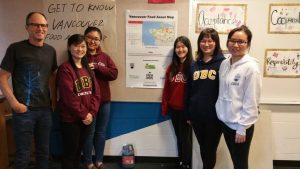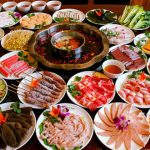What
In week 10, our group did the food asset map trailing in Britannia Community Center. We arrived there at around 10 a.m., then we met the community partner Ian, a very outgoing, helpful and enthusiastic man, and did the set up to be ready to introduce our food asset map. When we were trailing the map with community members, Ian helped a lot. For instance, every time community members came in, he introduced our food asset map to them and told them that we were UBC students and we were here to test food asset map. With Ian’s help, most of the community members would like to spend 5 minutes to trail the map with us, and everyone who has participated in the trailing were willing to complete the feedback form. After being in the community for up to 5 hours, we received 16 feedback forms from community members, which is a huge success. The majority of them even gave us very specific and detailed comments, which could help actually indicate the deficiencies and improve the food asset map. During the 5 hours, we had a chance to talk with Ian and got to know there is a huge gap between the rich and the poor in Grandview-woodland Community. Also, when we talked with low-income community members, we were able to feel how important do sufficient and nutritious food mean to them. All the gaining gave us an opportunity to apply our knowledge to real life.
So What
The community visit was definitely the highlight of our experience in LFS350 course. Before we went there, we used to think we were there to help them, to teach them how to find local food asset, because we were from UBC LFS faculty i.e. higher educated. However, it turned out that what they taught us was much more than that we gave to them. This reminds us of the very first concept we have learned in LFS350 class: “transdisciplinarity”, which emphasizing learning from non-academic people. Just as stated in a report from International Panel of Experts on Sustainable Food Systems, “the knowledge generated and held by farmers, fishers, forest-dwellers, food industry workers, cooperatives, consumer groups, civil society movements, indigenous populations and a whole range of other practitioners is one of the greatest untapped resources in the quest to reform food systems.” (2015, cited by LFS350 Session 1). We really appreciated that LFS350 gives us this chance to learn from the locals, and to get the first-hand experience with the people we want to serve in the future. This “Community-Based Experiential Learning” opportunity was definitely the best way that we can get ourselves familiar with Community Food Security, which is the core issue of LFS350 course (LFS350 Session 1).
Specifically to our project, this community experience also showed us the power of asset-based community development (ABCD). As defined by Mathie and Cunningham, ABCD is “identifying and mobilizing existing (but often unrecognized) assets, thereby responding to and creating local economic opportunity” (Mathie, A., & Cunningham, G., 2003). Therefore, the role of the outsiders, like us, is to direct the local people to their local assets, but not to create any new asset (LFS350 Session 2). We used to doubt the effectiveness of this “local-serve-local” model, especially giving the background of our community (low-income, limited local resources). Before we trialing the map, we were unsure how we could improve community food security by just a MAP, but not introducing any new food programs or kitchen workshops. However, the map trialing experience helped us became confident of this ABCD model. We observed how the community members appreciate the existing local assets and how they value the information from the map to guide them towards better food access. More importantly, because we were talking about the assets that are created and belongs to them, they felt they were respected. The feeling of dignity made them more engaged with our project. Some of them spent hours talking with us or even posted our project on their Facebook. This reflects what Ernesto said in his TED talk, “the first principle of aid is respect” (Sirolli, E., 2012, cited by LFS350 Session 3). We need to listen to the locals by heart. We need to put the “citizens of the community, rather than external experts, at the center of development” (LFS350 Session 2). We would definitely keep this in mind.
Now What
Consequence of the action:
We are the connection between community residents and food and health-related organizations. By the completion of the survey in the community, Grandview-woodland, we got a deep understanding of what ordinary residents really need, especially low-income populations. Since local residents are the service object, the opinion of them seems to be essential for improvements of the food asset map. Based on the survey results, organizations will be able to make changes towards the map on a generalization of professional terminologies, simplification of map usage and timely information update. On the contrary, through collecting the viewpoints from community members, they will have a feeling that being valued, by which, they will take the map more reliable. Moreover, this event is also a good way to propagate food asset map, make it more popular among people.
Broader issues need to be considered if this action is to be successful:
If our project is successful that establish a tight connection between community residents and food-related organizations, food security and food justice can be enhanced to some extent, to ensure healthy food is accessible to everyone equally, no matter rich or poor. Furthermore, the food asset map is helpful, aims at providing information to local people about the location and some details of various programs, food sources. However, this is not enough. The related department needs to take actions on supervision, make sure the authenticity and reliability of the information. To achieve this, we suggest to add evaluation system into the food asset map, not only for offering a better choice to consumers but also for the promotion of improvements in different programs.
Further actions:
In terms of our work, in the future, we can expand the range of the survey object. Since all the feedbacks we collected were from the low-income population, the results could not reflect the opinions of the groups with higher income. Food asset map is aiming at providing service to all local residents, thus if we could get feedback from higher-income groups, the information on the map could be improved to be more all-sided. Moreover, the design of the survey questions could be more detailed and more straightforward, as survey objects were not professional, some words could be more simple or given the explanation, such as food access.

Reference
Mathie, A., & Cunningham, G. (2003). From clients to citizens: Asset-based Community Development as a strategy for community-driven development. Development in Practice, 13(5), 474–486
International Panel of Experts on Sustainable Food Systems (2015). The New Science of Sustainable Food Systems.
Sirolli, E. (2012). Want to help someone? Shut up and listen! Retrieved November 27, 2016, from https://www.ted.com/talks/ernesto_sirolli_want_to_help_someone_shut_up_and_list en?language=en
Session 1 – Course Introductions. Retrieved November 27, 2016, from http://lfs350.landfood.ubc.ca/session-notes/term-1-session-notes/session-1/
Session 2 – Asset-Based Community Development + Food Justice. Retrieved November 27, 2016, from http://lfs350.landfood.ubc.ca/session-notes/term-1-session-notes/session-1/
Session 3 – Flexible Learning. Retrieved November 27, 2016, from http://lfs350.landfood.ubc.ca/session-notes/term-1-session-notes/session-1/


